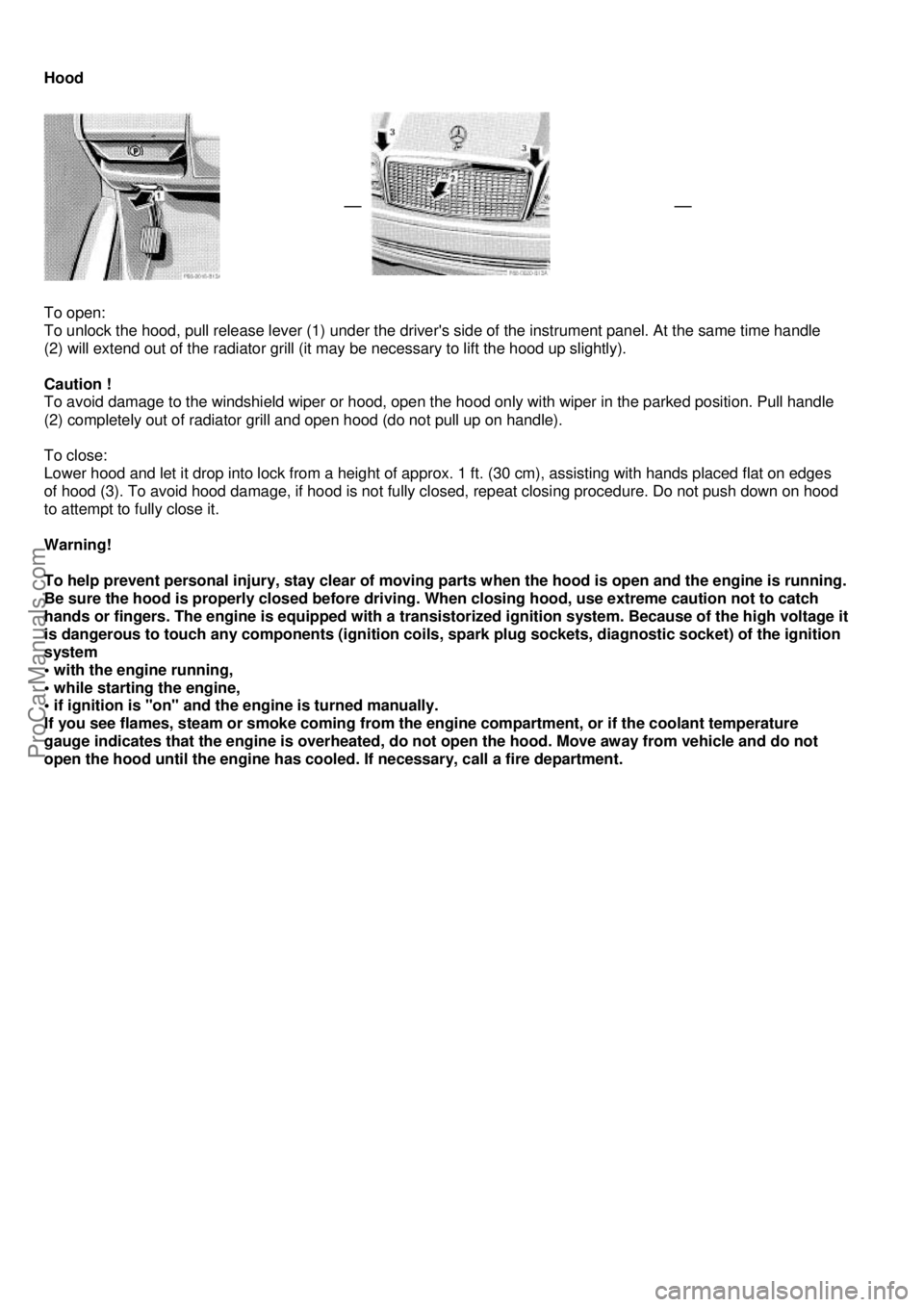1999 MERCEDES-BENZ C-280 light
[x] Cancel search: lightPage 64 of 122

Important !
Coasting the vehicle, or driving for any other reason with selector lever in "N" can result in transmission damage
that is not covered by the Mercedes-Benz Limited Warranty.
D - The transmission automatically upshifts through 5th gear . Position "D" provides optimum driving characteristics
under all normal operating conditions.
4 - Upshift through 4th gear only.
Suitable for performance driving. To shift from position "D" to "4", push selector lever to the left.
3 - Upshift through 3rd gear only.
Suitable for moderately steep hill s. Since the transmission does not shift hi gher than 3rd gear, this gear selection
will allow use of the engine's braking power downhill.
2 - Upshift through 2nd gear only.
For driving in mountainous regions or under extreme operating conditions. This gear selection will allow use of the
engine's braking power when descending steep grades.
1 - In this position, the engine's
braking effect is utilized by shifting into 1 st gea r. Use this position while descending very steep or lengthy
downgrades and only at speeds below 40 mph (60 km/h).
Important !
With selector lever in position "D", "4" or "3", upshifting from 1st to 2nd to 3rd gear is delayed depending on vehicle
speed and engine temperature. This allows the catalytic converter to heat up more quickly to operating temperatures.
During the brief warm-up period this delayed upshift and increased engine noise might be perceived as a malfunction.
However, neither the engine nor transmission are negatively affected by this mode of operation.
The delayed upshift is effective with vehicle speeds below 31 mph (50 km/h) at partial throttle and engine
temperatures below 95°F (35°C). To avoid overrevving the engi ne when the selector lever is moved to a lower driving
range, the transmission will not shift to a lower gear as l ong as the vehicle speed exceeds the speed limit of that gear.
To prevent the engine from laboring at low RPMs, do not allow the engine speed to drop too low on uphill gradients.
Depending on the degree of the incline, shift selector feve r to a lower gear range early enough to maintain engine
RPM within the best torque range.
Warning!
On slippery road surfaces, never downshift in order to obtain braking action. This could result in rear wheel
slip and reduced vehicle control. Your vehicle's AB S will not prevent this type of loss of control.
Maneuvering
To maneuver in tight areas, e.g. when pulling into a parki ng space, control the car speed by gradually releasing the
brakes. Accelerate gently and never abr uptly step on the accelerator. To rock a car out of soft ground (mud or snow),
alternately shift from forward to reverse, while applying slight partial throttle. Rocking a car free in this manner may
cause the ABS malfunction indicator lamp to come on. Turn off and restart the engine to clear the malfunction
indication.
Stopping
For brief stops, e.g. at traffic lights, leave the transmission in gear and hold vehicle with the service brake. For longer
stops with the engine idling, shift into "N" or "P" and hold t he vehicle with the service brake. When stopping the car on
an uphill incline, do not hold it with the accelerator, use the brake. This avoids unnecessary transmission heat build
up.
Warning !
Getting out of your car with the selector lever not fully engaged in position "P" is dangerous. Also, when
parked on an incline, position "P" alone may not pr event your vehicle from moving, possibly hitting people
or objects. Always set the parking brake in addition to sh ifting to position "P". When parked on an incline,
also turn front wheel against curb.
ProCarManuals.com
Page 66 of 122

Cruise Control
Cruise Control
Any given speed above approximately 22 mph (35 km/h) can be maintained with the cruise control by operating the
lever.
1. Accelerate and set:
Lift lever briefly to set speed. Hold lever up to accelerate.
2. Decelerate and set:
Depress lever briefly to set sp eed. Hold lever down to decelerate.
Normally the vehicle is accelerated to the desired speed with the accelerator. Speed is set by briefly pushing
the lever to position 1 or 2. The accelerator can be released. The speed can be increased (e.g. for passing)
by using the accelerator. As soon as the accelerator is released, the previously set speed will be resumed
automatically. If a set speed is to be increased or decreased slightly, e.g. to adapt to the traffic flow, hold lever in
position 1 or 2 until the desired speed is reached, or br iefly tip the control lever in the appropriate direction for
increases or decreases in 0.6 mph (1 km/h) increment s. When the lever is released, the newly set speed remains.
3. Canceling
To cancel the cruise control, briefly push lever to position 3.
When you step on the brake or the vehicle speed drops below approx. 22 rnph (35 km/h), for example when driving
upgrade, the cruise control will be canceled. If the cruise control cancels by itself and remains inoperative until the
engine is restarted, have the syst em checked at your authorized Mercedes -Benz dealer as soon as possible.
4. Resume
If the lever is briefly pushed to position 4 when drivi ng at a speed exceeding approx. 22 mph (35 km/h), the vehicle
resumes the speed which was set prior to the cancella tion of the cruise control. The last memorized speed is
canceled when the key in the steering lock is turned to position 1 or 0.
Note:
If the engine does not brake the vehicle sufficiently while dr iving on a downgrade, the speed you set on the cruise
control may be exceeded and you may have to step on the brake pedal to slow down.
As soon as the grade eases, the cruise controlled speed w ill again be maintained as long as the brakes were not
previously applied, or the lever may be used to resume the previously set speed if the brakes were applied.
Caution !
Moving gear selector lever to position "N" switches the cruise control off.
Warning !
Only use the cruise control if the traffic and weather conditions make it advisable to travel at a steady speed.
• The use of cruise control can be dangerous on winding roads or in heavy traffic because conditions do not
allow safe driving at a steady speed.
• The use of cruise control can be dangerous on slippery roads. Rapid changes in tire adhesion can result
in wheel spin and loss of control.
The "Resume" function should only be operated if the driv er is fully aware of the previously set speed and
wishes to resume this particular preset speed.
ProCarManuals.com
Page 67 of 122

Charge Indicator Lamp
Should the charge indicator lamp fail to come on prior to starting when the electronic key is in steering lock position 2
or should it fail to go out after starting or during operati on, this indicates a fault which must be repaired at an
authorized Mercedes-Benz dealer immediately.
If the charge indicator lamp comes on while the engine is ru nning, this may indicate that the poly-V-belt has broken.
Should this condition occur, the poly-V-bel t must be replaced before continuing to operate the vehicle. Otherwise, the
engine will overheat due to an inoperative water pump which may result in damage to the engine.
Do not continue to drive the vehicle with the charge indicator lamp illuminated. Doing so could result in serious engine
damage that is not covered by the Mercedes-Benz Limited Warranty.
Low Engine Oil Level Warning Lamp
With the electronic key in steering lock position 2, the o il level warning lamp comes on. It should go out immediately
when the engine is running.
If the warning lamp does not go out after starting the engi ne, or comes on with the engine running and at operating
temperature, the engine oil level has dropped to approximately the minimum mark on the dipstick.
When this occurs, the warning lamp will first come on intermittently and then stay on if the oil level drops further.
If no oil leaks are noted, continue to drive to the nearest service station where the engine oil should be topped to the
"full" mark on the dipstick with an approved oil.
The low engine oil level warning light should not be ignored. Extended driving with the light illuminated could result in
serious engine damage that is not covered by the Mercedes -Benz Limited Warranty. In addition to the warning lamp,
the engine oil level should be periodically checked with the di pstick (or via the odometer display - Model 280 only), for
example during a fuel stop, or before a long trip (see Index)
ProCarManuals.com
Page 70 of 122

Low Engine Coolant Level Warning Lamp
With the electronic key in steering lock position 2, the warning lamp comes on.
It should go out when the engine is running. If the warning lamp does not go out after starting the
engine, or if it comes on while driving, then the coolant level has dropped below the required level. If
no leaks are noticeable and the engine temperature does not increase, continue to drive to the
nearest service station and have coolant added to the coolant system (see Index).
The low engine coolant level warning light should not be ignored. Extended driving with the light
illuminated may cause serious engine damage not co vered by the Mercedes-Benz Limited Warranty.
In cases of major or frequent minor coolant lo ss, have the cooling system checked at your
authorized Mercedes-Benz dealer as soon as possible.
Note:
Do not drive without coolant in the cooling sy stem. The engine will overheat causing major engine
damage. Monitor the coolant temperature gauge while driving.
Warning !
Do not spill antifreeze on hot engine parts. Antifreeze contains ethylene glycol which may
burn if it comes into contact with hot engine parts. You can be seriously burned.
Low Windshield and Headlamp Washer System Fluid Level Warning Lamp
With the electronic key in steering lock position 2, the warning lamp comes on. It should go out when
the engine is running. If the warning lamp does not go out after starting the engine, or if it comes on
while driving, the level of the reservoir has droppe d to approx.1/4 of the total volume. The reservoir
should be refilled with MB Windshield Washer Concentrate "S" and water (or commercially available
premixed windshield washer solvent/antifreeze, depending on ambient temperature - see Index) at
the next opportunity. The reservoir for the windshie ld and headlamp washer systems is located in
the engine compartment.
ProCarManuals.com
Page 71 of 122

Exterior Lamp Failure Indicator Lamp
With the electronic key in steering lock position 2, an indicator lamp comes on. It should go out when the engine is
running. If the warning lamp does not go out after starting the engine, or if it comes on while driving, this lamp
indicates a failure in the parking lamp, taillamp, stop lamp, or low beam headlamp. If an exterior lamp fails, the
indicator lamp will come on only when that lamp is switched on. If a brake lamp fails, the lamp failure indicator will
come on when applying the brake and st ay on until the engine is turned off.
Note:
If additional lighting equipment is installed (e.g. auxiliary headl amps etc.) be certain to connect into the fuse before
the failure indicator monitoring unit in order to avoid damaging the system.
Brake Pad Wear Indicator Lamp
With the electronic key in steering lock position 2, the brake pad wear indicator lamp comes on for approximately 30
seconds. It goes out when the engine is running.
If the indicator lamp lights up during braking, this indica tes that the brake pads are worn down. Have the brake
system checked at your authorized Mercedes- Benz dealer as soon as possible.
Brake Warning Lamp
With the electronic key in steering lock position 2, the brake warning lamp will come on. It should go out when the
engine is running. The brake warning lamp will come on:
• when there is insufficient brake fluid in the rese rvoir (engine running and parking brake released), or
• when the parking brake is set (engine running).
Warning !
Driving with the brake warning lamp on can result in an accident. Have your brake system checked
immediately if the brake warning lamp stays on. Don't add brake fluid before checking the brake system.
Overfilling the brake fluid reservoir can result in spilling brake fluid on hot engine parts and the brake fluid
catching fire. You can be seriously burned.
If you find that the minimum mark on the brake fluid reserv oir is reached, have the brake system checked for brake
pad thickness and leaks. To test the brake warning lamp, turn electronic key in steering lock to position 2. The brake
warning lamp comes on, and should go out when the engine is running.
ProCarManuals.com
Page 73 of 122

Antilock Brake System (ABS)
Important !
The ABS improves steering control of the vehicle during braking maneuvers. Do not pump the brake pedal, rather use
firm, steady brake pedal pressure. Pu mping the brake pedal defeats the pur pose for ABS and significantly reduces
braking effectiveness.
The ABS prevents the wheels from locking up above a vehicl e speed of approximately 5 mph (8 km/h) independent of
road surface conditions.
At the instant one of the wheels is about to lock up, a slight pulsation can be felt in the brake pedal, indicating that the
ABS is in the regulating mode. Keep firm and steady pressure on the brake pedal while experiencing the pulsation.
On slippery road surfaces, the ABS will re spond even with light brake pedal pressure because of the increased
likelihood of locking wheels. The pulsating brake pedal can be an indication of hazardous road conditions and
functions as a reminder to take extra care while driving.
ABS Control
The ABS malfunction indicator lamp in the instrument cl uster comes on with the electronic key in steering lock
position 2 and should go out when the engine is running.
If the charging voltage falls below 10 volts, the malfunction indicator lamp comes on and the ABS is switched off.
When the voltage is above this value again, the malfunction indicator lamp should go out and the ABS is operational.
With the ABS malfunctioning, the ASR or ESP, if vehicl e so equipped, are also switched off. Both malfunction
indicator lamps come on with the engine running. If the ABS malfunction indicator lamp does not go out or comes on
while driving, it indicates that the ABS has detected a malfunction and has switched off. In this case, the brake
system functions in the usual manner, but without antilock assistance.
Have the system checked at your authorized Mercedes-Benz dealer as soon as possible.
Warning !
ABS cannot prevent the natural laws of physics from acting on the vehicle, nor can it increase the traction
made available by the road conditions. The ABS ca nnot prevent accidents, including those resulting from
excessive speed in turns, following another vehicle too cl osely, or aquaplaning. Only a safe, attentive, and
skillful driver can prevent accidents. The capabilities of an ABS equipped car must never be exploited in a
reckless or dangerous manner which could jeopardize the user's safety or the safety of others.
Note:
To alert following vehicles to slippery road conditions you discover, operate your hazard warning flashers as
appropriate.
ProCarManuals.com
Page 79 of 122

Hood
To open:
To unlock the hood, pull release lever (1) under the driver's
side of the instrument panel. At the same time handle
(2) will extend out of the radiator grill (it may be necessary to lift the hood up slightly).
Caution !
To avoid damage to the windshield wiper or hood, open the hood only with wiper in the parked position. Pull handle
(2) completely out of radiator grill and open hood (do not pull up on handle).
To close:
Lower hood and let it drop into lock from a height of approx. 1 ft. (30 cm), assisting with hands pl aced flat on edges
of hood (3). To avoid hood damage, if hood is not fully cl osed, repeat closing procedure. Do not push down on hood
to attempt to fully close it.
Warning!
To help prevent personal injury, stay clear of moving parts when the hood is open and the engine is running.
Be sure the hood is properly closed before driving. When closing hood, use extreme caution not to catch
hands or fingers. The engine is equipped with a transi storized ignition system. Because of the high voltage it
is dangerous to touch any components (ignition coils , spark plug sockets, diagnostic socket) of the ignition
system
• with the engine running,
• while starting the engine,
• if ignition is "on" and the engine is turned manually.
If you see flames, steam or smoke coming from the engi ne compartment, or if the coolant temperature
gauge indicates that the engine is overheated, do not open the hood. Move away from vehicle and do not
open the hood until the engine has cooled. If necessary, call a fire department.
ProCarManuals.com
Page 88 of 122

Changing Wheels
Move vehicle to a level area which is a safe distance from the road way.
1 . Set parking brake and turn on hazard warning flasher.
2 . Move selector lever to position "P" and turn off engine.
3 . Prevent vehicle from rolling away by blocking wheels with wheel chocks
(not supplied with vehicle) or sizable wood block or stone. When changing a wheel
on a hill, place chocks on the downhill side blocking both wheels of the other axle.
On a level road, place one chock in front of and one behind the wheel that is
diagonally opposite to the wheel being changed.
4 . Using the wrench, loosen but do not yet remove the wheel bolts.
5
. Remove the protective cover from the jack support tube opening by inserting the
screwdriver (supplied in the tool kit) in the opening and prying it out. The tube
openings are located directly behind the front wheel housings and in front of the
rear wheel housings.
6
. Insert jack arm fully into the tube hole up to the stop.
Place jack on firm ground. Position the jack so that it is always vertical (plumb-line)
as seen from the side (see arrow), even if the vehicle is parked on an incline.
7. Jack up the vehicle until the wheel is clear of the ground.
Never start engine while vehicle is raised.
8 . Unscrew upper-most wheel bolt and install alignment bolt (1) supplied in the
tool kit. Remove the remaining bolts. Keep bolt threads protected from dirt and
sand.
9. Remove wheel. Grip wheel from the sides. Keep hands from beneath the wheels.
10. Clean contact surfaces of wheel and wheel hub. Install spare wheel on wheel
hub.
Insert wheel bolts and tighten them slightly. To avoid paint damage, place wheel
flat
against hub and hold it there while installing first wheel bolt.
Unscrew the alignment bolt (1) to install the last wheel bolt.
11. Lower car. Remove jack and insert jack tube cover. Before storing the jack,
the jack arm must be lowered almost to the base of the jack.
Warning !
Always replace wheel bolts that are damaged or rusted.
Never apply oil or grease to wheel bolts. Damaged wheel hub threads should
be repaired immediately.
Incorrect mounting bolts or improperly tightened mounting bolts can cause the
wheel to come off. This could cause an accident. Be sure to use the correct
mounting bolts.
12.
Using the wrench, tighten the five bolts evenly, following the sequence illustrated
above, until all bolts are tight. Obse rve a tightening torque of 80 ft.lb. (110 Nm).
13. Ensure proper tire pressure.
ProCarManuals.com